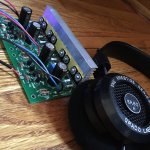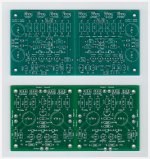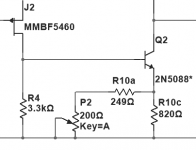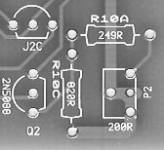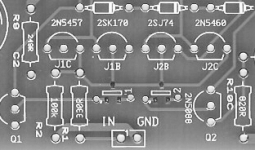SOTA performance
Did you have any trouble matching the input devices? And, what is your power supply voltage? Did you try a higher voltage? Glad you find the sound excellent by any standard.
It varies from the original Hiraga in that he didnt realize the distortion of electrolytic caps. I changed it to this configuration to eliminate those caps. That was the new and preferred circuit after Hiraga. A few years later, i invented the dc servo concept and told walt Jung..... btw-- Walt Jung first introduced the dc servo via his DIY phono preamp. Now, no one needs to have caps as coupling or in the feedback signal path.
By selecting the jFETs as instructed, you get zero temp coefficient so not even a dc servo is needed. Ultra pure sound.
The sm versions of the jFEts may be a little harder to solder and handle but seems to be what will be most available when the nos is depleted from the market place. The only problem will be in matching them due to small physical size.
Glad you built it and are enjoying the music.
THx-RNMarsh
With the dual PS I have, caps right after the PS and then on to the board, excellent sound, by any standard. This with Hifiman HE-560, Foxtex TH900 recabled with Whiplash gold/silver and so on. Being fed by the Chord Hugo or the Sony ZX2.
Did you have any trouble matching the input devices? And, what is your power supply voltage? Did you try a higher voltage? Glad you find the sound excellent by any standard.
It varies from the original Hiraga in that he didnt realize the distortion of electrolytic caps. I changed it to this configuration to eliminate those caps. That was the new and preferred circuit after Hiraga. A few years later, i invented the dc servo concept and told walt Jung..... btw-- Walt Jung first introduced the dc servo via his DIY phono preamp. Now, no one needs to have caps as coupling or in the feedback signal path.
By selecting the jFETs as instructed, you get zero temp coefficient so not even a dc servo is needed. Ultra pure sound.
The sm versions of the jFEts may be a little harder to solder and handle but seems to be what will be most available when the nos is depleted from the market place. The only problem will be in matching them due to small physical size.
Glad you built it and are enjoying the music.
THx-RNMarsh
Last edited:
Did you have any trouble matching the input devices? And, what is your power supply voltage? Did you try a higher voltage? Glad you find the sound excellent by any standard.
It varies from the original Hiraga in that he didnt realize the distortion of electrolytic caps. I changed it to this configuration to eliminate those caps. That was the new and preferred circuit after Hiraga. A few years later, i invented the dc servo concept and told walt Jung..... btw-- Walt Jung first introduced the dc servo via his DIY phono preamp. Now, no one needs to have caps as coupling or in the feedback signal path.
By selecting the jFETs as instructed, you get zero temp coefficient so not even a dc servo is needed. Ultra pure sound.
The sm versions of the jFEts may be a little harder to solder and handle but seems to be what will be most available when the nos is depleted from the market place. The only problem will be in matching them due to small physical size.
Glad you built it and are enjoying the music.
THx-RNMarsh
I am running it at 15 volts. I know you said the sweet spot was 18 but I already had one supply at the 15 and just wanted to give each channel a supply.
Yes sm are harder to work with but a jig should be easy to make to do the testing. Soldering isn't that bad, just don't use to much solder, right. :^)
Hello jackinnj,
Been reading this thread lately... would it be possible to reduce the gain to 6db without affecting (much) the performance or changing the character of the amp?
also, how critical the PSU quality (unregulated vs regulated, feedback regulated vs series, smps vs linear) for this amp performance?
thanks, david
Been reading this thread lately... would it be possible to reduce the gain to 6db without affecting (much) the performance or changing the character of the amp?
also, how critical the PSU quality (unregulated vs regulated, feedback regulated vs series, smps vs linear) for this amp performance?
thanks, david
I did not try it at lower gain.... I can control level going into the HPA from source or a pot on input.
The PS is important. how critical? Depends on your expectations..... for best possible sound, use the best possible PS. I did not do anything more than simple regulator and it measures and sounds great.
If someone has tried more complex PS, we would like to hear your experience.
THx-RNMarsh
The PS is important. how critical? Depends on your expectations..... for best possible sound, use the best possible PS. I did not do anything more than simple regulator and it measures and sounds great.
If someone has tried more complex PS, we would like to hear your experience.
THx-RNMarsh
I did not try it at lower gain.... I can control level going into the HPA from source or a pot on input.
The PS is important. how critical? Depends on your expectations..... for best possible sound, use the best possible PS. I did not do anything more than simple regulator and it measures and sounds great.
If someone has tried more complex PS, we would like to hear your experience.
THx-RNMarsh
I would like to do a PS with inductor loading. As the field collapses around the inductor, there is a type of regulation going and you have the storage of energy in the inductor. I do this for tube supplies, 150 or higher H. I have 4 150H inductors. I should try it. I am happy with the sound of my amp though, with the dual PS's and added FC caps right after the PS. Very clean, natural, open, and dynamic.
I'm so busy at work I'm basically relegated to lurking here...sigh. However, I finally got the tracking version working that jackinnj hinted to me to try. I am using a 317 with a LT1963a, both for V+ and V- using a dual secondary trafo. (I know, Mongo say CT trafo go BOOM!)
Now I just have to go back to review what are the recommended trafo VA requirements and I should be able to wrap it up soon. I have the board 90% populated. I just need to set up the output transistors with heatsink and remove a biasing diode from each channel. Ohh so close.
Now I just have to go back to review what are the recommended trafo VA requirements and I should be able to wrap it up soon. I have the board 90% populated. I just need to set up the output transistors with heatsink and remove a biasing diode from each channel. Ohh so close.
I did not try it at lower gain.... I can control level going into the HPA from source or a pot on input.
The PS is important. how critical? Depends on your expectations..... for best possible sound, use the best possible PS. I did not do anything more than simple regulator and it measures and sounds great.
If someone has tried more complex PS, we would like to hear your experience.
THx-RNMarsh
Thanks Richard... how much maximum current that could be sent out by your amp (thus to calculate the maximum current supply needed for PS)?
Hi,
The OPS of each amp idles at about 100mA iirc. Check what others here have done.
If you want the best topology...... IMO - use a master-slave and/or push-pull shunt reg.
THx-RNMarsh
The OPS of each amp idles at about 100mA iirc. Check what others here have done.
If you want the best topology...... IMO - use a master-slave and/or push-pull shunt reg.
THx-RNMarsh
Last edited:
Hmmm, I'm not familiar with those terminologies(master-slave/push-pull shunt)...off to do some research.
Hi,
The OPS of each amp idles at about 100mA iirc. Check what others here have done.
If you want the best topology...... IMO - use a master-slave and/or push-pull shunt reg.
THx-RNMarsh
Thanks Richard,
I would need to learn a lot on the shunt regulator types... 😱
Regards, david
Hello Jackiinj, I put an order for the amp pcb and the part kit. One each is enough for stereo, right?
How high the voltage rail I could apply to the amp based on yor kit parts?
How high the voltage rail I could apply to the amp based on yor kit parts?
Last edited:
Finally got the heatsink mounted and am burning my Marsh in. The sound isn't bad right out of the box. A little muted on the highs and lows but typical of new electronics (and headphone drivers). 😛
WOW does that heatsink get hot! I can touch it but not for more than a second. I'll have to borrow a Fluke IR meter to make sure they are running safe. I am only running at +/-15V right now.
WOW does that heatsink get hot! I can touch it but not for more than a second. I'll have to borrow a Fluke IR meter to make sure they are running safe. I am only running at +/-15V right now.
Attachments
Looks very nice. What PS voltage are you using? And, if you changed OP stage devices, you may need to delete one of the bias diodes.
-Richard
-Richard
Last edited:
Looks very nice. What PS voltage are you using? And, if you changed OP stage devices, you may need to delete one of the bias diodes.
-Richard
+/-15V ... I am using Jack's kit with the 2SD669AC and 2SB649AC ... should I short one diode?
should I short one diode?
Just do it - it's easy 🙂. It will run much cooler for sure; if it sounds different is up to you to decide. Mine didn't, neither got the THD any worse.
Yes, I removed one of the diodes and it runs MUCH cooler now! I then went from +/-15V to +/-18V and it still stays only slightly warm but sounds much better at the higher voltage. It seems to be taking much less effort now. The sound is more open and dynamic.
Now I just need a better set of cans than my SR60's! 😛 I was at AXPONA this past weekend and listened to a lot of different headphones. I am REALLY liking the Oppo PM-2 planars. They also just happen to be 32 ohm impedance as well! I still want to hear a set of RS1's before I pull the trigger though.
Now I just need a better set of cans than my SR60's! 😛 I was at AXPONA this past weekend and listened to a lot of different headphones. I am REALLY liking the Oppo PM-2 planars. They also just happen to be 32 ohm impedance as well! I still want to hear a set of RS1's before I pull the trigger though.
I have had a run of requests for boards -- ran out several weeks ago. I was thinking to modify a bit by providing for adjustment of the 2N5087/8 and allowing folks to use SMT input JFETs, or K170/J74.
Hello, jackinnj
Could you tall me about possibility to buy this modified version of board with kit.
Thanks a lot.
Last edited:
The boards are in! Offer remains the same -- $3 which is my cost (but you'll have to pay the postage).
Layout is a bit different -- I allow for a potentiometer to trim the value of R10, you can use the TO-92 or SMT versions of 2N5457/5460 or 2SK170/2SJ74. The optimal size for the trimmers is the Bourns 1/4 inch variety.
The new potentiometer arrangement, layout, etc:
Layout is a bit different -- I allow for a potentiometer to trim the value of R10, you can use the TO-92 or SMT versions of 2N5457/5460 or 2SK170/2SJ74. The optimal size for the trimmers is the Bourns 1/4 inch variety.
The new potentiometer arrangement, layout, etc:
Attachments
- Home
- Amplifiers
- Headphone Systems
- Marsh headphone amp from Linear Audio
